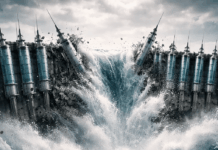
By Cinch Home Services,
As homeowners, we know that no home is completely disaster-proof. However, we can take many steps that might make all the difference to prepare our homes for events that may be unpredictable or beyond our control.
We often see the impact of such preparations on the news: when catastrophe strikes, there are often stark differences in how neighboring properties fare. Some homes are devastated, while others sustain only minor damage. So what’s the difference between properties?
Exploring recent examples of disaster-related property damage can help us learn more about the updates our own homes might need. According to Kiplinger finance magazine, the year 2017 was “one of the worst on record for natural disasters in the U.S., with with more than $300 billion in property damage,” including 16 different weather-related events that each resulted in losses of over $1 billion. Most often, the homes that fare the best under these circumstances are those that are best prepared.
How can you improve your odds of making it through a disaster with your home unscathed? From keeping wood piles away from the house to fortifying roof trusses and installing impact-resistant windows, there are many measures homeowners can take toward making their homes more disaster-resistant. Some require a financial investment, while others cost little or nothing. Nearly all of these suggestions require a little elbow grease, but it’s worth it. The reward — an intact home after a disaster — can protect you and your loved ones from unimaginable outcomes.
Remember: Preparation is the best way to protect yourself and your home in a disaster. Use the tips in this guide to make your home more disaster-resistant.
Part 1: Preparations to make upfront
Disaster preparedness begins with understanding the types of emergencies you might face. As a homeowner or tenant, there are certain things you should always do up front, no matter where you live or what type of home you live in.
Knowing the risk factors prevalent in your area will help inform you of the best disaster prep choices for your home. For example, certain areas and topographies are associated with greater risk of floods or earthquakes. Begin your preparations by considering the greatest risk factors in your area: fires, floods, hurricanes, earthquakes, tornadoes, drought, blizzards or any combination of those.
You should also know when your home was built and whether its construction meets current building codes. For instance, some homes in earthquake zones may need to be retrofitted with stabilization depending on when and how the home was originally constructed.
Also, take time to evaluate your home’s strengths and weaknesses. Pay careful attention to your home’s weaknesses — the roof, windows and foundation (if there is one) are good places to start — and begin looking for ways to strengthen these areas.
Another simple but important step to take in advance is to sign up for emergency alerts. The emergency alert system will notify you on your mobile device when you are in danger. Getting these alerts can be lifesaving in emergency events, giving you critical time to respond. Ready.gov, the American Red Cross and the National Weather Service offer mobile emergency alert apps. Plus, most local governments offer access to a statewide emergency alert system.
When disaster strikes, many people often have more pressing concerns than personal documents. That’s why it’s important to protect important documents such as birth certificates, passports, property deeds and insurance records, so they can be accessed in the aftermath. Some people put important documents and items in a safe deposit box in a bank — but you can only access one of these during bank hours and contents can be difficult to retrieve if the owner is not present or able to grant access. Instead, invest in a safe or a water- and fireproof box to store your important documents safely on the premises.
Know your community’s disaster plans and warning systems. For example, if you live in a hurricane zone, your community will have a hurricane plan in place. Familiarize yourself with these disaster plans and warning systems. You should also locate the nearest Red Cross chapter, which is searchable by zip code on the Red Cross website.

Make a family disaster plan
While you can’t control a natural disaster, you can devise a system to help yourself and loved ones get through safely. The best time to do this is now, while you have time to create a preparedness kit and family disaster plan. If catastrophe strikes, you may not have the time or resources you’d need to assemble your ideal kit.
Build a preparedness kit
Unfortunately, reports suggest only 38% of American households keep an emergency kit at home for severe weather. Don’t be part of this percentage. Compose an emergency kit that contains at least the following items:
- Water (one gallon of water per person per day for at least three days of drinking and sanitation)
- Food (enough nonperishable food for at least three days)
- First-aid kit
- Battery-powered radio and NOAA weather radio
- Flashlights
- Extra batteries
- Whistle
- Dust mask
- Plastic sheeting and duct tape
- Moist towelettes
- Garbage bags and plastic ties
- Wrench or pliers for shutting off utilities
- Manual can opener
- Local maps (on paper)
- Cell phone with chargers and a backup battery
It’s recommended that you keep one emergency kit each in your home, your vehicle and at your workplace. You can also purchase pre-made emergency kits from the Red Cross.
You should also devise a family disaster plan and communicate it to all members of your household. These are the basic elements of a family disaster plan:
- Appoint a contact person (ideally someone who does not live with you) and make sure everyone carries written contact information for this person and other family members.
- Designate a meeting place in case an emergency separates your family members. This should include one place outside your home for sudden emergencies and another outside your neighborhood for disasters requiring evacuation.
- Show all members of your household where emergency kits and rescue items are stored and how they are used.
- Identify your home’s escape routes (such as in case of a fire) and safe places (such as where to go during a tornado). Practice evacuating the home several times a year and plan alternate routes in case roads are closed.
- Place ICE (In Case of Emergency) information in an easy-to-see place in your home.
For assistance creating your family disaster plan, visit Red Cross Make-a-Plan. It’s also important to know the disaster plans at your workplace, your children’s school or daycare and other places your family frequents.
Set up basic home preparations for disasters
In addition to knowing the basics about your home, community and local emergency systems, you can also take some basic steps around your home to lay the groundwork for better disaster resistance. The initial safety checks and repairs below can mean the difference between disaster making a major impact or a minor one on your home:
- Have your electrical and plumbing systems inspected regularly.
- Rather than waiting, repair any damage to your home promptly. A disaster will likely worsen already existing damage that could result in major consequences.
- Caulk and fill cracks in drywall and plaster as they are discovered.
- Change the batteries in smoke detectors and carbon monoxide detectors yearly.
- Inspect your trees annually and trim branches and other vegetation as needed.
- Keep at least one fire extinguisher on each floor of your home. Especially make sure there’s one accessible in the kitchen.
- Know where your electric, gas and water shut-off valves are and how to operate them.
- Set aside one day a year to test all your home safety devices and check for needed repairs. Mark the day on your calendar and make sure not to miss it!
Source: https://www.cinchhomeservices.com
Disclaimer: We at Prepare for Change (PFC) bring you information that is not offered by the mainstream news, and therefore may seem controversial. The opinions, views, statements, and/or information we present are not necessarily promoted, endorsed, espoused, or agreed to by Prepare for Change, its leadership Council, members, those who work with PFC, or those who read its content. However, they are hopefully provocative. Please use discernment! Use logical thinking, your own intuition and your own connection with Source, Spirit and Natural Laws to help you determine what is true and what is not. By sharing information and seeding dialogue, it is our goal to raise consciousness and awareness of higher truths to free us from enslavement of the matrix in this material realm.
 EN
EN FR
FR

























